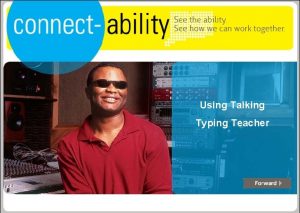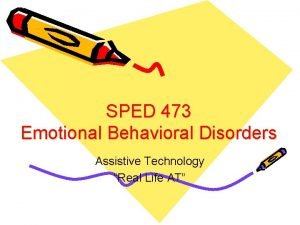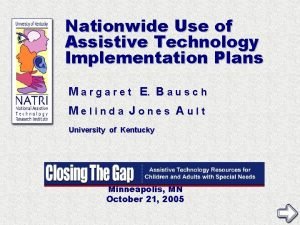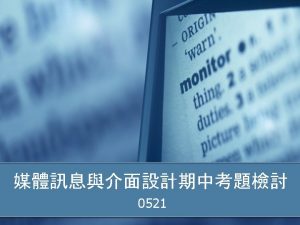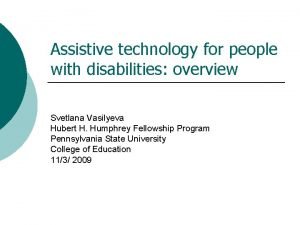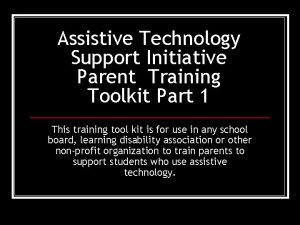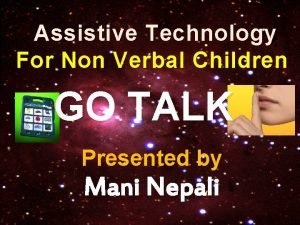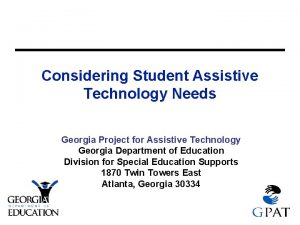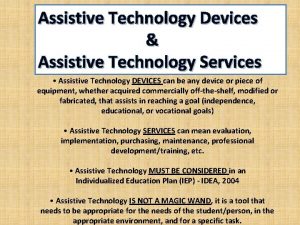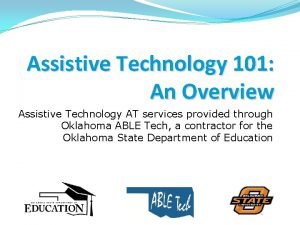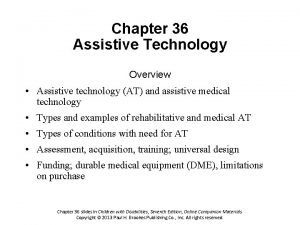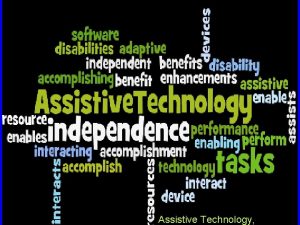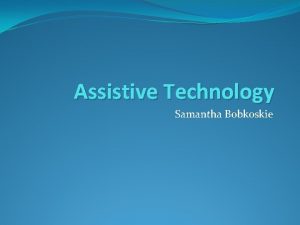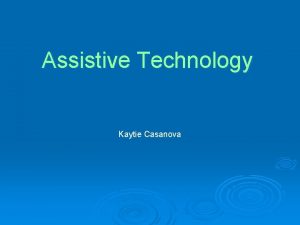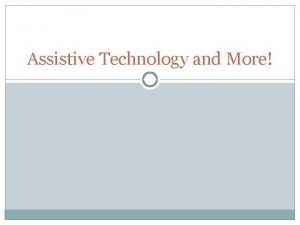Assistive Technology Tools Assistive technology tools are tools











- Slides: 11

Assistive Technology Tools

Assistive technology tools are tools that assist those who are visually impaired, developmentally physically challenged and deaf/hard of hearing with the use of technology.

Assistive Technology for the Visually Impaired

Screen Reader- is a program that combines sound and picture to help describe what is on a computer screen Closed Circuit Magnification- is a device that can amplify words and objects on a screen for easier viewing Braille Translation Devicesare used to convert screen words and formatting into braille

Pros and Cons Academic Gains Barriers �Screen Reader- gives both a visual and sound for comprehension �Closed Circuit Magnificationgreat visual aid for those who are visually challenged but not blind �Braille Translation Devicesgreat for those who are completely blind �Screen Reader- not so great for those who are both blind audio impaired �Closed Circuit Magnificationthe device can become a distraction for those in the classroom with impaired child �Braille Translation Devicesbecomes a barrier if child has not yet been taught how to read braille

Assistive Technology for the Developmentally Physically Challenged

Adaptive Keyboard- is a keyboard that decreases the strain on the user by alphabetizing the letters Alternative Communication Devices- Are devices that helps those with Down ’s Syndrome, Autism, and other disabilities communicate without difficulty Adaptive Student Desk- are for children with neurological deficiencies, these desk modify to their necessities

Pros and Cons Academic Gains Barriers �Adaptive Keyboard- assist with easily locating keys �Alternative Communication Devices- great for non verbal students to communicate with others �Adaptive Student Deskmakes the classroom setting more comfortable for those students who need them �Adaptive Keyboard- May hinder the development of adapting to a Qwerty keyboard later in life �Alternative Communication Devices – the device may glitch or cause interaction problems �Adaptive Student Desk- may not be in every room due to expense

Deaf and Hard of Hearing

Personal Amplification Device- Is an acoustic enhancer that directly increases the sound of noise nearby the consumer Audio/visual communication devices- Combines residual hearing with closer views of the mouth movement to enhance comprehension Voice to text translation- A software device that captures articulated words and translates it into intelligible text on screen

Pros and Cons Academic Gains Barriers �Personal Amplification Device- great for individualized assistance �Audio/visual communication devices- good tool for those who read lips/ mouth movement �Voice to text translationgreat for those who are only hearing impaired but not for those who are both blind and deaf �Audio/visual communication devices– the device may hinder the learning environment for others by providing distraction �Voice to text translationcauses problems for young learners who can not yet read and of course the usual technology issues of glitching
 Insidan region jh
Insidan region jh Typing assistive technology
Typing assistive technology Assistive technology for emotional disturbance
Assistive technology for emotional disturbance Assistive technology implementation plan
Assistive technology implementation plan Assistive technology wikipedia
Assistive technology wikipedia Meaning of assistive technology
Meaning of assistive technology Language tools
Language tools Illinois assistive technology program
Illinois assistive technology program Don johnson assistive technology
Don johnson assistive technology Go talk assistive technology
Go talk assistive technology Georgia project for assistive technology
Georgia project for assistive technology Assistive technology toys
Assistive technology toys

